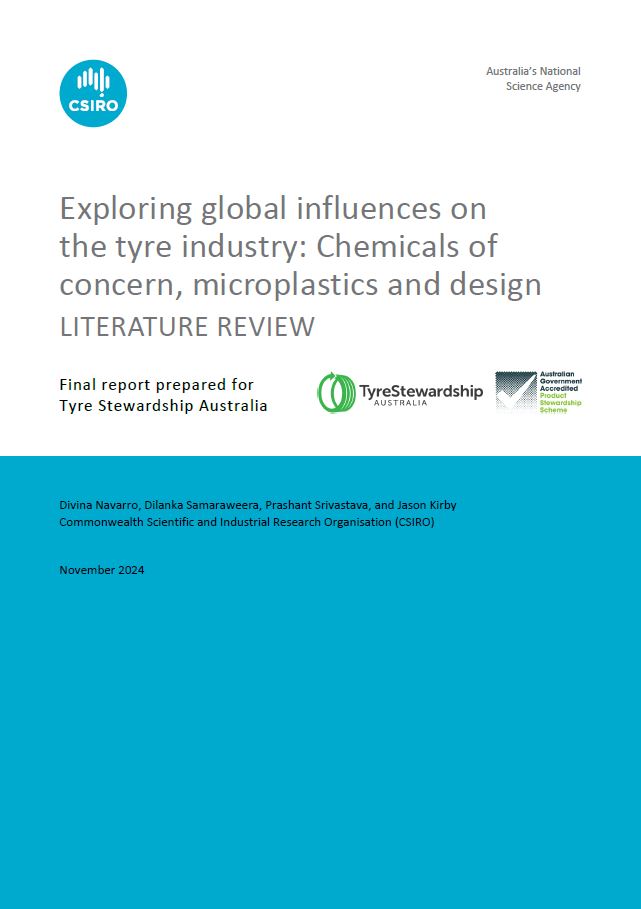Exploring global influences on the tyre industry: Chemicals of concern, microplastics and design - Literature Review
Growing interest regarding the chemicals present in tyres has prompted responses from tyre manufacturers, researchers, and regulators, leading to new research initiatives and regulations globally.
As Australia considers new strategies for end-of-life tyre management and seeks to increase and diversify the end markets for tyres, a comprehensive understanding of the global context in tyre design, development, regulation, and management becomes crucial.
TSA has recently collaborated with CSIRO on the study "Exploring Global Influences on the Tyre Industry" to improve understanding of evolving global regulations and innovations relating to the design of new tyres, their chemical composition, action towards the mitigation of tyre wear, and the relevance of these topics for Australia.
Click here to download the full report.
1. Regulatory changes
Global priorities on tyre regulation are generally aligned on improving safety and reducing environmental impact. However, approaches vary by region, with some being more proactive and others more reactive, reflecting local regulatory priorities and influences. Overall, the regulations and policies identified promote the following changes in tyres:
• alternative and more sustainable rubber sources;
• increased incorporation of recycled materials and product circularity;
• tyres with reduced wear to limit particle emissions;
• substitution of chemicals of concern in tyres with no loss of performance or safety;
• exploration of alternatives for other chemicals of concern.
2. Industry Alignment and Innovation
Tyre manufacturers, along with regulatory alignment, are emphasising initiatives to meet sustainability objectives (reducing carbon emissions and deforestation) and key performance needs such as safety (e.g., wet grip) and fuel efficiency (e.g., rolling resistance). The replacement of chemicals of concern and reduction in tyre wear appears secondary in these initiatives, perhaps because global regulations regarding these contaminants from tyres are still evolving. With all these factors influencing manufacturing, tyre design has needed to adapt both structurally (tread designs, size, thickness, and reinforcements) and chemically (sustainable rubber sources, recycled raw materials, new fillers, and other additives).
3. Global Research Efforts
Global efforts to address chemicals of concern receive less attention on individual manufacturer websites and are instead featured in large-scale collaborations among industry associations and government bodies.
• The Tire Industry Project (or TIP) is committed to various research efforts, considering tyre emissions (particularly with proposed Euro 7 standards), mitigation and end-of-life impacts.
• The U.S. Tyre Manufacturers Association is exploring alternatives to replace 6PPD, (precursor to toxic 6PPD-Q), driven by the real risk of a future restriction or ban on this chemical from both individual states like California, and at a Federal level under the Toxic Substances Control Act (TSCA).
• Projects like BlackCycle in Europe, focus on technology, markets and sustainability for end-of-life tyres.
4. Adapting Recycling Processes
To meet sustainability and performance expectations, the tyre industry is embarking on significant innovations such as new rubber compositions, (guayule, dandelion rubber), bio-derived material (soybean and sunflower oils), nano- and other technical materials. However, it is currently unclear what impact these changes will have on existing end-of-life solutions for tyres. Questions arise, such as can emerging processes like pyrolysis and devulcanisation and can end-markets with strict technical specifications accommodate the diversity and variability of these changes, especially though multiple life cycles? To achieve sustainable tyre manufacturing by 2050, integrating new designs, materials and chemicals into development of end-of-life processing is crucial. Whole-of-life considerations are necessary for new tyres to understand their fit in current EOL markets and potential impacts on human health and the environment.
5. The Context for Australia
Global trends and standards can offer valuable guidance for future tyre material regulations in Australia. At point of import, any regulatory standards will need to adapt to the Australian context, balancing international acceptance along with local practicality and considerations for human health and environmental impacts. Similarly, impacts and pathways to end-of-life, recovery and reuse should be considered during the evaluation of any tyre material regulations.
It is also important to consider the consequences of regional standards on tyre materials, such as tyre wear (Euro 7) and 6PPD (US TSCA) restrictions. Non-compliant tyres could be redirected to regions with less stringent regulations, including Australia. On the other hand, if Australia imposes similar restrictions, the tyre industry might face higher costs, supply chain disruptions, and reduced competitiveness.
In summary, remaining informed on global developments in tyre manufacturing, research and regulation will lead to better decisions on reprocessing technologies and end-markets for used tyres. A balanced regulatory approach for Australia would be one that considers human health and environmental impacts, whilst avoiding undue burdens on industry, and considers local capabilities and economic impacts. Collaboration among tyre manufacturers, regulatory agencies, researchers, and organisations like TSA is crucial for generating local data, strengthening future strategies and ensuring a circular economy for all used tyres.
